BY DAVID SEATER
On February 29, 2016, Central Seattle Greenways volunteers and Seattle Neighborhood Greenways staff met at Capitol Hill Station to conduct an accessibility audit of the station area. We focused on three priorities: safety of street crossings, obstructions in crosswalks and along sidewalks, and sidewalk capacity. The station is expected to serve 14,000 riders every day in 2030, making safety and accessibility of the entrances a significant priority.
The map below shows the audit area. Intersections that were assessed are circled, station entrances are marked with stars. Specifically, the intersections were: Broadway E & E John St / E Olive Way, Broadway E & E Denny Way, Broadway Ave E & E Thomas St, Harvard Ave E & E Olive Way, and 10th Ave E & E John St.
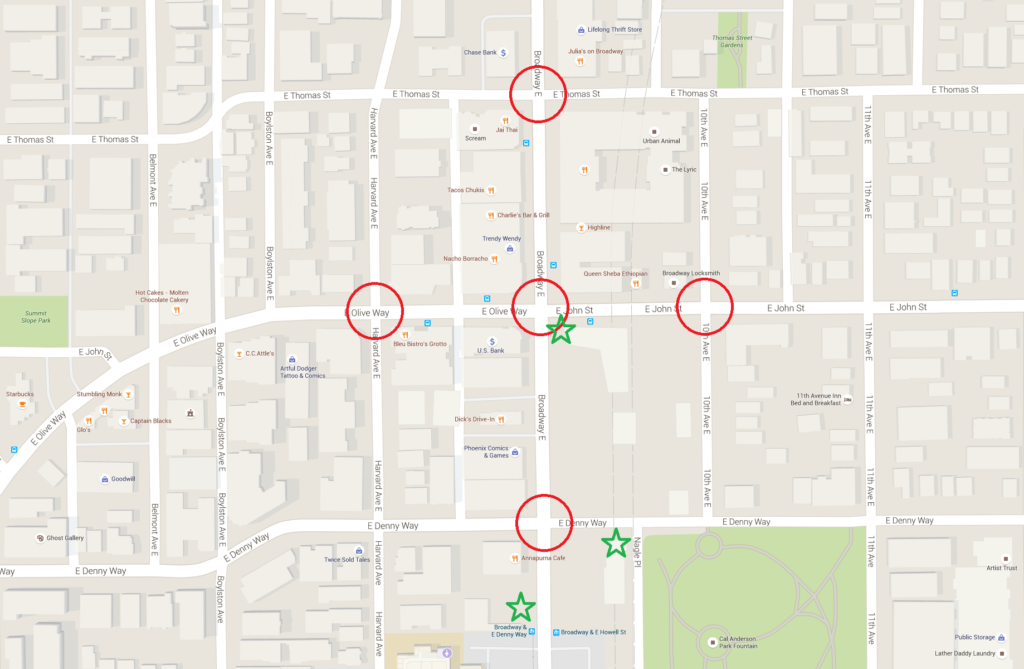 Assessed intersection are circled in red, station entrances are marked with green stars. (Map from Google Maps, annotations by David Seater)
We identified several common problems at the intersections and the sidewalks connecting them:
Assessed intersection are circled in red, station entrances are marked with green stars. (Map from Google Maps, annotations by David Seater)
We identified several common problems at the intersections and the sidewalks connecting them:
- Obstructions (poles, hydrants) in or very near curb ramps
- Obstructions (poles, signal cabinets, A-boards) blocking painted crosswalks
- Ramps misaligned on opposite sides of a crosswalk
- Ramps turned at an angle to the crosswalk
- Drivers making dangerous turns through occupied crosswalks
- Difficult crossings of John (at 10th) and Olive (at Harvard)
- Sidewalks narrowed by obstructions (trash cans, newspaper boxes, A-boards, shelters)
Easy Wins - Quick, low cost solutions:
- Relocate trash cans and newspaper boxes to be further from crosswalks and ramps
- Move trash cans and newspaper boxes closer to the curb to open up sidewalk space
- Work with businesses to prevent A-boards from blocking crosswalks and sidewalks
- Install crosswalk markings and signs at Harvard & Olive Way and 10th & John
- Install better signage and lane markings to prevent left turns from northbound Broadway to westbound Denny Way
- Coordinate with King County Metro to place bus shelters without obstructing sidewalks
- Patch utility cuts with asphalt to cover existing gravel and create a smooth surface
- Remove or replace the old bike rack on the sidewalk on the west side of Broadway between John and Thomas
Future Opportunities - Sidewalk and ramps:
- Relocate or underground utility and signal control cabinets. Many of these are placed directly in the path of marked crosswalks, creating a barrier and reducing capacity. This is particularly apparent at the main station entrance on the southeast corner of Broadway E & E John St.
- Relocate utility and signal poles, many of which are blocking marked crosswalks. Some of the poles are partially blocking ADA ramps.
- Relocate fire hydrants that are blocking crosswalks and ADA ramps. These are particularly difficult for people with impaired vision to navigate around.
- Align ADA ramps on both sides of crosswalks so that people walking across the street can travel in a straight line without encountering an unexpected curb.
- Orient ADA ramps to be aligned with the crosswalk instead of at an angle. In particular, avoid using a single ramp that directs people walking into the middle of the intersection. The new ramp directly in front of the main station entrance at Broadway E & E John St is a particularly egregious example of what not to do.
Safety Improvements - Arterial crosswalks:
- Rechannelize E John St / E Olive Way to add left turn lanes at Broadway E. The lack of turn lanes here causes drivers to change lanes unexpectedly as they approach and move through the intersection.
- Add left turn signal phases in all directions at Broadway E & E John St / E Olive Way. When the intersection is busy it’s common for drivers attempting to turn left to loiter in crosswalks or in the intersection waiting for a gap in oncoming traffic without watching for people crossing in the crosswalk. This leads to dangerous situations when drivers try to turn through an occupied crosswalk.
- Improve the crossings at Harvard & Olive Way and 10th & John with raised intersections, curb bulbs, or other traffic calming measures. Many drivers do not yield to people trying to walk across these intersections.
Examples:
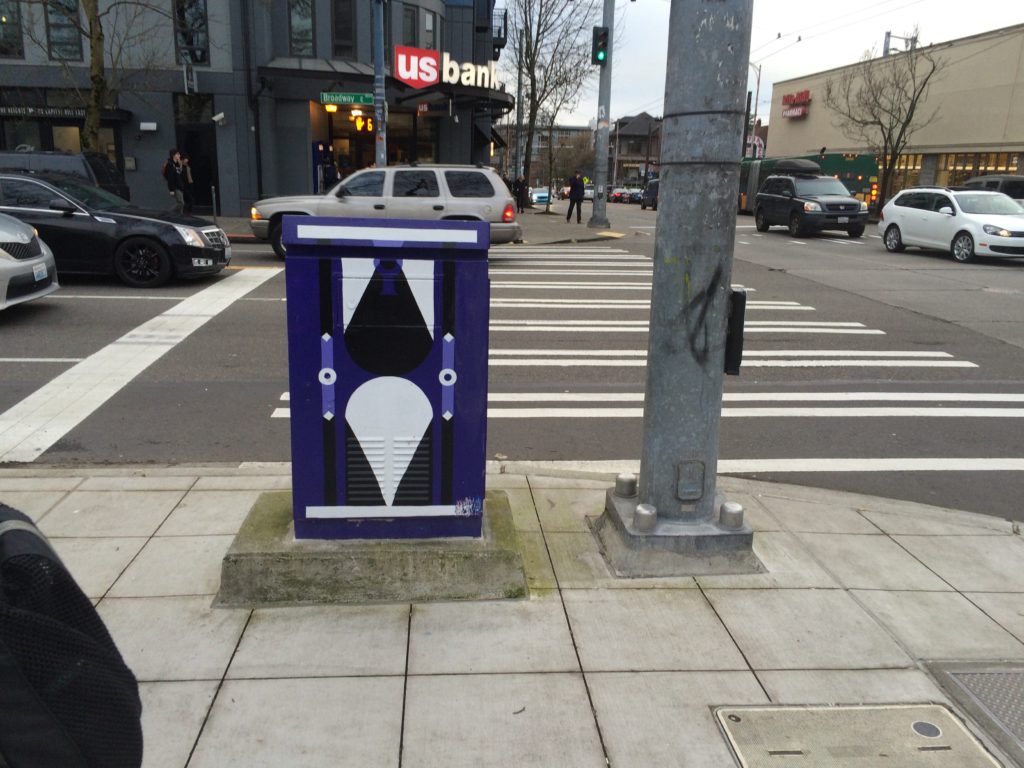 Obstructed crosswalk, Broadway E & E John St (photo from Seattle Neighborhood Greenways)
Obstructed crosswalk, Broadway E & E John St (photo from Seattle Neighborhood Greenways)
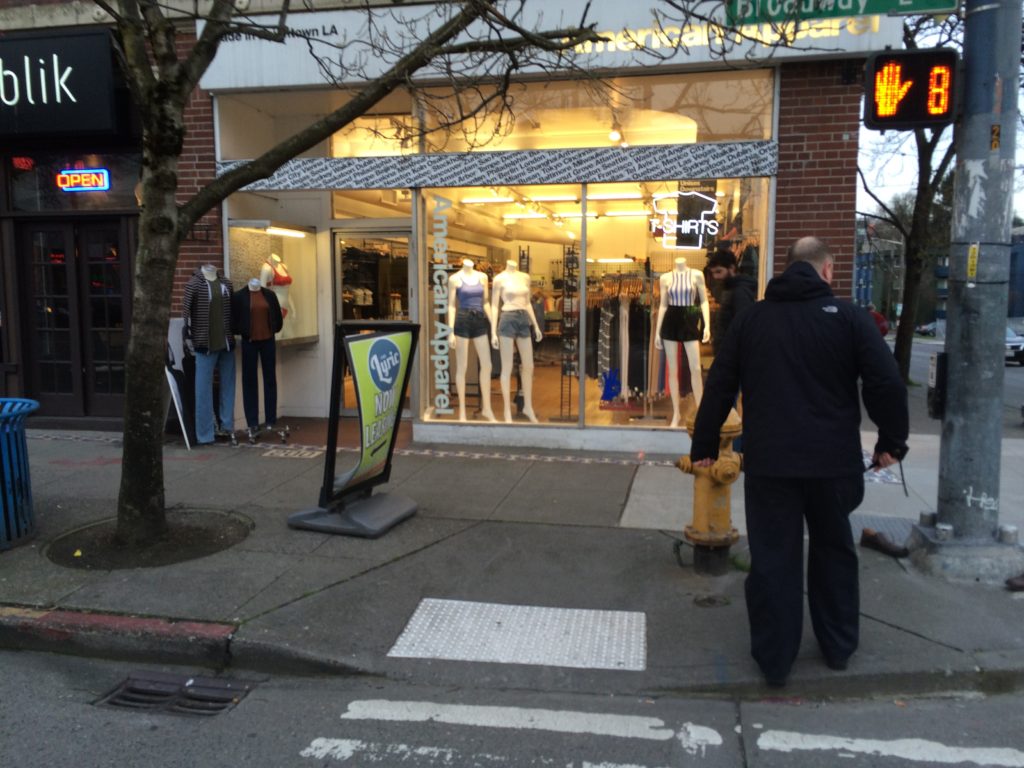 Obstructed crosswalk, Broadway E & E John St (photo from Seattle Neighborhood Greenways)
Obstructed crosswalk, Broadway E & E John St (photo from Seattle Neighborhood Greenways)
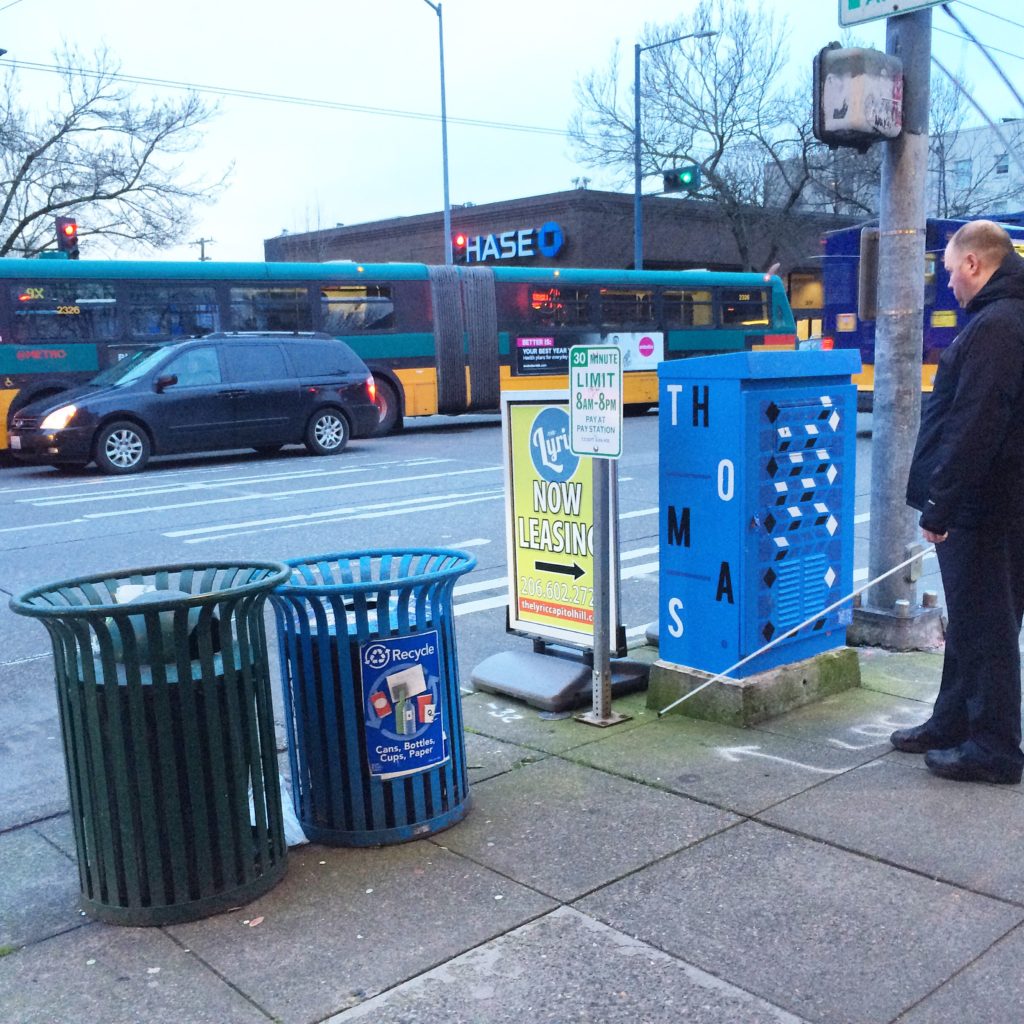 Obstructed crosswalk, Broadway E & E Thomas St (photo from Seattle Neighborhood Greenways)
Obstructed crosswalk, Broadway E & E Thomas St (photo from Seattle Neighborhood Greenways)
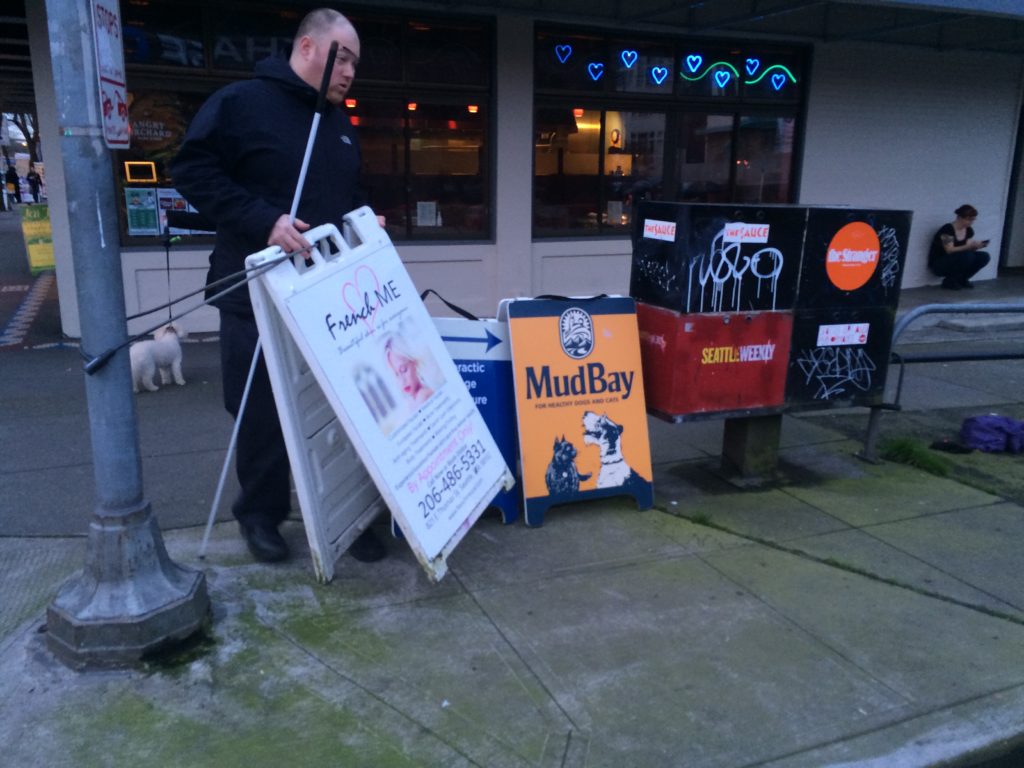 Sidewalk obstructions, Broadway E & E Thomas St (photo from Seattle Neighborhood Greenways)
Sidewalk obstructions, Broadway E & E Thomas St (photo from Seattle Neighborhood Greenways)
 Left-turning car stuck in crosswalk, Broadway E & E John St / E Olive Way (photo from David Seater)
Left-turning car stuck in crosswalk, Broadway E & E John St / E Olive Way (photo from David Seater)
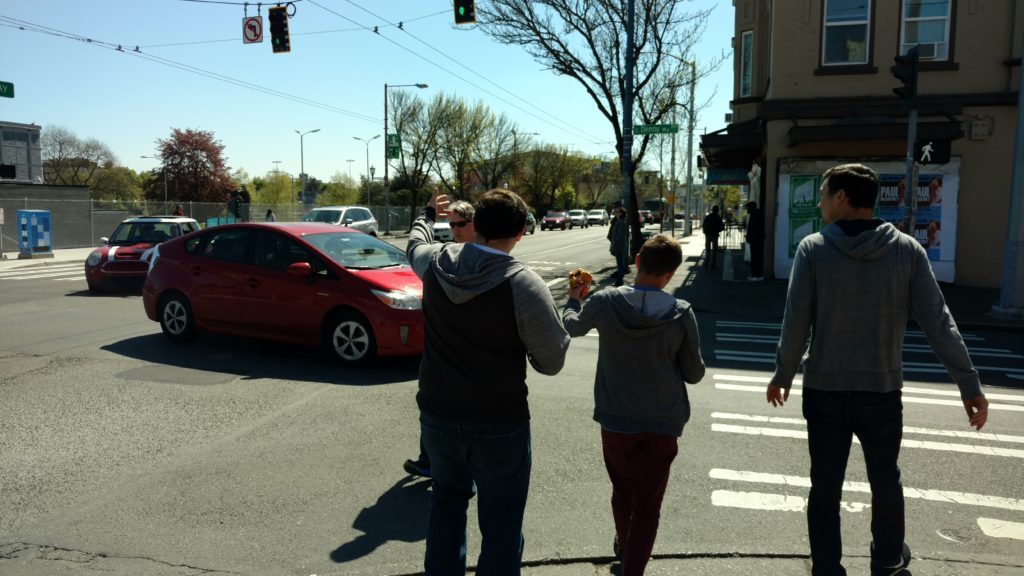 Illegal turns into occupied crosswalk, Broadway E & E Denny Way (photo from David Seater)
Illegal turns into occupied crosswalk, Broadway E & E Denny Way (photo from David Seater)
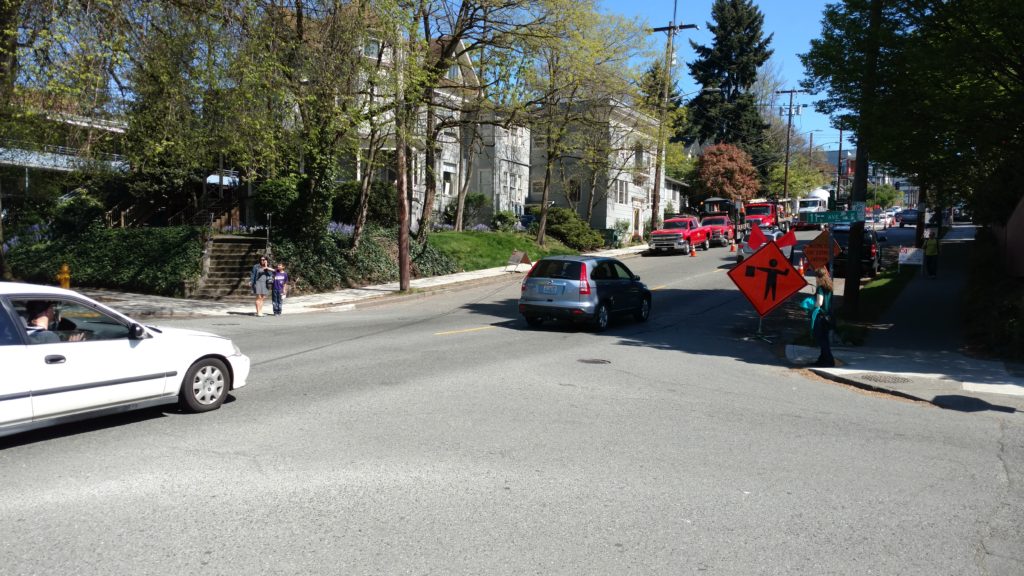 Failure to yield, 10th Ave E & E John St (photo from David Seater)
Failure to yield, 10th Ave E & E John St (photo from David Seater)
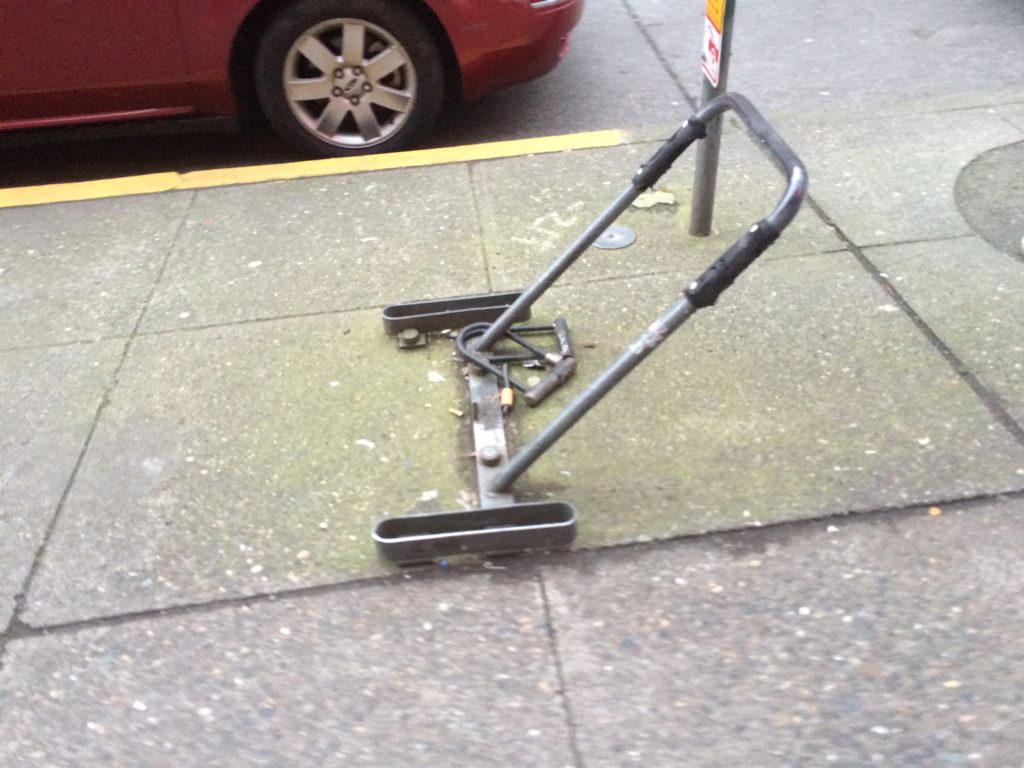 Old bike rack, Broadway E between E John and E Thomas Streets (photo from Seattle Neighborhood Greenways)
Old bike rack, Broadway E between E John and E Thomas Streets (photo from Seattle Neighborhood Greenways)
 Assessed intersection are circled in red, station entrances are marked with green stars. (Map from Google Maps, annotations by David Seater)
We identified several common problems at the intersections and the sidewalks connecting them:
Assessed intersection are circled in red, station entrances are marked with green stars. (Map from Google Maps, annotations by David Seater)
We identified several common problems at the intersections and the sidewalks connecting them:
 Obstructed crosswalk, Broadway E & E John St (photo from Seattle Neighborhood Greenways)
Obstructed crosswalk, Broadway E & E John St (photo from Seattle Neighborhood Greenways)
 Obstructed crosswalk, Broadway E & E John St (photo from Seattle Neighborhood Greenways)
Obstructed crosswalk, Broadway E & E John St (photo from Seattle Neighborhood Greenways)
 Obstructed crosswalk, Broadway E & E Thomas St (photo from Seattle Neighborhood Greenways)
Obstructed crosswalk, Broadway E & E Thomas St (photo from Seattle Neighborhood Greenways)
 Sidewalk obstructions, Broadway E & E Thomas St (photo from Seattle Neighborhood Greenways)
Sidewalk obstructions, Broadway E & E Thomas St (photo from Seattle Neighborhood Greenways)
 Left-turning car stuck in crosswalk, Broadway E & E John St / E Olive Way (photo from David Seater)
Left-turning car stuck in crosswalk, Broadway E & E John St / E Olive Way (photo from David Seater)
 Illegal turns into occupied crosswalk, Broadway E & E Denny Way (photo from David Seater)
Illegal turns into occupied crosswalk, Broadway E & E Denny Way (photo from David Seater)
 Failure to yield, 10th Ave E & E John St (photo from David Seater)
Failure to yield, 10th Ave E & E John St (photo from David Seater)
 Old bike rack, Broadway E between E John and E Thomas Streets (photo from Seattle Neighborhood Greenways)
Old bike rack, Broadway E between E John and E Thomas Streets (photo from Seattle Neighborhood Greenways)